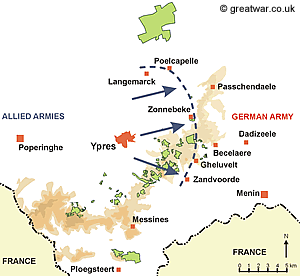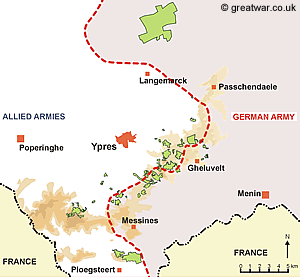Ypres Salient Battles 1914
- Ypres occupied by the German Army.
07-Oct-1914
- Battle of Messines, 1914
12-Oct-1914 —
02-Nov-1914
- Germans driven out of Ypres and the surrounding area by Allied forces.
13-Oct-1914
- First Battle of Ypres, 1914
19-Oct-1914 —
22-Nov-1914
The line (blue dashed line) held by the British Army east of Ypres at the start of the First Battle of Ypres on 19th October 1914. 
This battle occurred in the late autumn at a crucial point in the “Race to the Sea”, when the Allied Armies and the German Armies were engaged in an attempt to outflank one another in a desire to reach and secure the ports on the northern French coast. With the agreement of the French Commander-in-Chief (General Joffre), the British Commander-in-Chief (Field-Marshal Sir John French) withdrew British forces of the British Expeditionary Force (B.E.F.) from their positions on the Aisne battlefield. They moved to Artois and Flanders to extend the left flank of the French Army and hold back the German advance towards the coast.
At the same time the British 3rd Cavalry Division and 7th Division were covering the withrawal of the Belgian Army from Antwerp. These two divisions were then moved to the east of Ypres on a line between Langemarck - Poelcapelle - Zonnebeke - Gheluvelt - Zandvoorde.
In September 1914 four new German Army Corps had been formed (approximately 48,000 men in total). Over two thirds of the men were young, inexperienced volunteers between 17 and 19 years of age (known as Kriegsfreiwillige). As a result of the young age of so many of the soldiers, the Corps became known as the “Kinderkorps”. The word “Kinder” translates as “children” in English.
These four Corps were incorporated into the newly established German Fourth Army. By 19th October, with only a few weeks of training, they were on the march towards Ypres from the north east. From 20th October they encountered the experienced, well-trained soldiers of the British Expeditionary Force (B.E.F.) who were holding a series of positions making up the forward British Line north-east and east of Ypres.
The Front Line (red dashed line) stabilized east of Ypres at the end of the 1st Battle of Ypres by 22nd November 1914. 
The First Battle of Ypres comprised three phases:
- The Battle of Langemarck
21-Oct-1914 —
24-Oct-1914
The four new German Corps of the German Fourth Army made an advance on the British Line north east of Ypres. German casualties were very heavy especially in the vicinity of Becelaere and Langemarck. The courageous but inexperienced young Germans in the “Kinderkorps” were cut down in their hundreds. Some regiments lost 70% of their strength in casualties. The British battalions fought to hold their ground but also lost casualties in dead, wounded and prisoners.
This battle has a special significance for the German people for this reason. Many soldiers who fell during this battle are now buried in the German military cemetery of Langemarck (nowadays it is spelt Langemark).
- Battle of Gheluvelt
29-Oct-1914 —
31-Oct-1914
On 29 October the German Army attacked the British Line on the Menin Road at Kruisecke Crossroads, east of Gheluvelt. The German aim was to break through the British front and take Ypres.
- Critical day: The British line is broken but restored.
31-Oct-1914
A very serious situation for the British developed with the German occupation of Gheluvelt but a successful counter-attack involving the 2nd Battalion the Worcestershire Regiment recaptured the village and restored the break in the British Front Line. Sir John French wrote of this momentous action: “I regard it as the most critical moment in the whole of this great battle.” (1)
- Messines village captured by the Germans.
01-Nov-1914
- Battle of Nonnebosschen
11-Nov-1914
- The Battle of Langemarck
Next >> Ypres Salient Battles 1915
Further Reading

First Ypres 1914 (paperback)
By David Lomas
This volume covers the first of the trench warfare battles of World War I. In the autumn of 1914 the original British Expeditionary Force made its last stand, aided by French troops, against the advancing German army racing towards the French ports. (Osprey Military Campaign Series)

Ypres: The First Battle 1914 (paperback)
by Ian F.W. Beckett
The battle for Ypres in October and November 1914 represented the last opportunity for open, mobile warfare on the Western Front. In the first study of First Ypres for almost 40 years, Ian Beckett draws on a wide range of sources never previously used to reappraise the conduct of the battle, its significance and its legacy.

The German Army at Ypres 1914 (hardcover)
by Jack Sheldon
The first complete account of the German Army's battles in the sector of Belgian Flanders in 1914. Jack Sheldon uses material from German military archives in Munich and Stuttgart to provide the perspective of events from the German side.
Related Topic

|
Many of the German soldiers killed in the First Battle of Ypres in the autumn of 1914 are buried or commemorated in the German Military Cemetery at Langemark.
Acknowledgements
(1) Despatch by Field-Marshal Sir John French, published in the Second Supplement of The London Gazette issue 28989 of Friday 27 November 1914, the Supplement being dated 30 November 1914, pages 10121-10132.
Website: www.london-gazette.co.uk 30 November 1914 pp 10121-10132